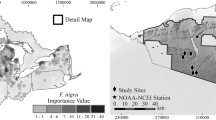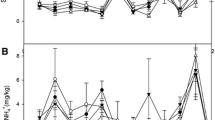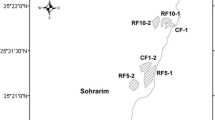Abstract
The impacts of exotic insects and pathogens on forest ecosystems are increasingly recognized, yet the factors influencing the magnitude of effects remain poorly understood. Eastern hemlock (Tsuga canadensis) exerts strong control on nitrogen (N) dynamics, and its loss due to infestation by the hemlock woolly adelgid (Adelges tsugae) is expected to decrease N retention in impacted stands. We evaluated the potential for site variation in N availability to influence the magnitude of effects of hemlock decline on N dynamics in mixed hardwood stands. We measured N pools and fluxes at three elevations (low, mid, high) subjected to increasing atmospheric N deposition where hemlock was declining or absent (as reference), in western North Carolina. Nitrogen pools and fluxes varied substantially with elevation and increasing N availability. Total forest floor and mineral soil N increased (P < 0.0001, P = 0.0017, resp.) and forest floor and soil carbon (C) to N ratio decreased with elevation (P < 0.0001, P = 0.0123, resp.), suggesting that these high elevation pools are accumulating available N. Contrary to expectations, subsurface leaching of inorganic N was minimal overall (<1 kg ha−1 9 months−1), and was not higher in stands with hemlock mortality. Mean subsurface flux was 0.16 ± 0.04 (SE) (kg N ha−1 100 days−1) in reference and 0.17 ± 0.05 (kg N ha−1 100 days−1) in declining hemlock stands. Moreover, although subsurface N flux increased with N availability in reference stands, there was no relationship between N availability and flux in stands experiencing hemlock decline. Higher foliar N and observed increases in the growth of hardwood species in high elevation stands suggest that hemlock decline has stimulated N uptake and growth by healthy vegetation within this mixed forest, and may contribute to decoupling the relationship between N deposition and ecosystem N flux.






Similar content being viewed by others
References
Aber J, McDowell W, Nadelhoffer K, Magill A, Berntson G, Kamakea M, McNulty S, Currie W, Rustad L, Fernandez I. 1998. Nitrogen saturation in temperate forest ecosystems—Hypotheses revisited. Bioscience 48:921–34.
Aber JD, Goodale CL, Ollinger SV, Smith ML, Magill AH, Martin ME, Hallett RA, Stoddard JL. 2003. Is nitrogen deposition altering the nitrogen status of northeastern forests? Bioscience 53:375–89.
Block CE, Knoepp JD, Fraterrigo JM. Interactive effects of disturbance and nitrogen availability on phosphorus dynamics of Southern Appalachian forests. Biogeochemistry (in press).
Boettcher SE, Kalisz PJ. 1990. Single-tree influence on soil properties in the mountains of eastern Kentucky. Ecology 71:1365–72.
Day FP, Phillips DL, Monk CD. 1988. Forest communities and patterns. In: Swank WT, Crossley DA Jr, Eds. Forest hydrology and ecology at Coweeta. New York: Springer-Verlag. p 141–9.
Elliott KJ, Vose JM. 2011. The contribution of the Coweeta Hydrologic Laboratory to developing an understanding of long-term (1934–2008) changes in managed and unmanaged forests. For Ecol Manage 261:900–10.
Ellison AM, Bank MS, Clinton BD, Colburn EA, Elliott K, Ford CR, Foster DR, Kloeppel BD, Knoepp JD, Lovett GM, Mohan J, Orwig DA, Rodenhouse NL, Sobczak WV, Stinson KA, Stone JK, Swan CM, Thompson J, Von Holle B, Webster JR. 2005. Loss of foundation species: consequences for the structure and dynamics of forested ecosystems. Front Ecol Environ 3:479–86.
Fenn ME, Poth MA, Aber JD, Baron JS, Bormann BT, Johnson DW, Lemly AD, McNulty SG, Ryan DE, Stottlemyer R. 1998. Nitrogen excess in North American ecosystems: predisposing factors, ecosystem responses, and management strategies. Ecol Appl 8:706–33.
Ford CR, Vose JM. 2007. Tsuga canadensis (L.) Carr. mortality will impact hydrologic processes in southern Appalachian forest ecosystems. Ecol Appl 17:1156–67.
Ford C, Elliott K, Clinton B, Kloeppel B, Vose J. 2011. Forest dynamics following eastern hemlock mortality in the southern Appalachians. Oikos 121:523–536.
Fritts HC. 1972. Tree rings and climate. Sci Am 226:92–100.
Gandhi KJK, Herms DA. 2010. Direct and indirect effects of alien insect herbivores on ecological processes and interactions in forests of eastern North America. Biol Invasions 12:389–405.
Jenkins JC, Aber JD, Canham CD. 1999. Hemlock woolly adelgid impacts on community structure and N cycling rates in eastern hemlock forests. Can J For Res 29:630–45.
Kizlinski ML, Orwig DA, Cobb RC, Foster DR. 2002. Direct and indirect ecosystem consequences of an invasive pest on forests dominated by eastern hemlock. J Biogeogr 29:1489–503.
Knoepp JD, Vose JM, Swank WT. 2008. Nitrogen deposition and cycling across an elevation and vegetation gradient in southern Appalachian forests. Int J Environ Stud 65:389–408.
Knoepp JD, Vose JM, Clinton BD, Hunter MD. 2011. Hemlock infestation and mortality: impacts on nutrient pools and cycling in Appalachian forests. Soil Sci Soc Am J 75:1935–45.
Langlois JL, Johnson DW, Mehuys GR. 2003. Adsorption and recovery of dissolved organic phosphorus and nitrogen by mixed-bed ion-exchange resin. Soil Sci Soc Am J 67:889–94.
Levine JM, D’Antonio CM. 2003. Forecasting biological invasions with increasing international trade. Conserv Biol 17:322–6.
Lovett GM, Goodale CL. 2011. A new conceptual model of nitrogen saturation based on experimental nitrogen addition to an oak forest. Ecosystems 14:615–31.
Lovett GM, Bowser JJ, Edgerton ES. 1997. Atmospheric deposition to watersheds in complex terrain. Hydrol Process 11:645–54.
Lovett GM, Weathers KC, Arthur MA, Schultz JC. 2004. Nitrogen cycling in a northern hardwood forest: do species matter? Biogeochemistry 67:289–308.
Lovett GM, Canham CD, Arthur MA, Weathers KC, Fitzhugh RD. 2006. Forest ecosystem responses to exotic pests and pathogens in eastern North America. Bioscience 56:395–405.
McClure MS. 1991. Density-dependent feedback and population-cycles in Adelges tsugae (Homoptera, Adelgidae) on Tsuga canadensis. Environ Entomol 20:258–64.
Nuckolls A, Wurzburger N, Ford C, Hendrick R, Vose J, Kloeppel B. 2009. Hemlock declines rapidly with hemlock woolly adelgid infestation: impacts on the carbon cycle of Southern Appalachian Forests. Ecosystems 12:179–90.
Ollinger SV, Smith ML, Martin ME, Hallett RA, Goodale CL, Aber JD. 2002. Regional variation in foliar chemistry and N cycling among forests of diverse history and composition. Ecology 83:339–55.
Orwig DA, Cobb RC, D’Amato AW, Kizlinski ML, Foster DR. 2008. Multi-year ecosystem response to hemlock woolly adelgid infestation in southern New England forests. Can J For Res 38:834–43.
Qualls RG, Haines BL, Swank WT, Tyler SW. 2000. Soluble organic and inorganic nutrient fluxes in clearcut and mature deciduous forests. Soil Sci Soc Am J 64:1068–77.
Quinn GP, Keough MJ. 2002. Experimental design and data analysis for biologists. 2nd edn. Cambridge: Cambridge University Press.
Stadler B, Muller T, Orwig D, Cobb R. 2005a. Hemlock woolly adelgid in New England forests: canopy impacts transforming ecosystem processes and landscapes. Ecosystems 8:233–47.
Stadler B, Müller T, Orwig D, Cobb R. 2005b. Hemlock woolly adelgid in New England forests: canopy impacts transforming ecosystem processes and landscapes. Ecosystems 8:233–47.
Susfalk RB, Johnson DW. 2002. Ion exchange resin based soil solution lysimeters and snowmelt solution collectors. Commun Soil Sci Plant Anal 33:1261–75.
Templer PH, McCann TM. 2010. Effects of the Hemlock woolly adelgid on nitrogen losses from urban and rural northern forest ecosystems. Ecosystems 13:1215–26.
Templer PH, Lovett GM, Weathers KC, Findlay SE, Dawson TE. 2005. Influence of tree species on forest nitrogen retention in the Catskill Mountains, New York, USA. Ecosystems 8:1–16.
van Breemen N, Boyer EW, Goodale CL, Jaworski NA, Paustian K, Seitzinger SP, Lajtha K, Mayer B, van Dam D, Howarth RW, Nadelhoffer KJ, Eve M, Billen G. 2002. Where did all the nitrogen go? Fate of nitrogen inputs to large watersheds in the northeastern USA. Biogeochemistry 57–58:267–93.
Weathers KC, Lovett GM, Likens GE, Lathrop R. 2000. The effect of landscape features on deposition to Hunter Mountain, Catskill Mountains, New York. Ecol Appl 10:528–40.
Weathers KC, Simkin SM, Lovett GM, Lindberg SE. 2006. Empirical modeling of atmospheric deposition in mountainous landscapes. Ecol Appl 16:1590–607.
Yorks TE, Leopold DJ, Raynal DJ. 2003. Effects of Tsuga canadensis mortality on soil water chemistry and understory vegetation: possible consequences of an invasive insect herbivore. Can J For Res 33:1525–37.
Acknowledgments
This project was supported by the USDA National Institute of Food and Agriculture, Hatch project #875-353 and by the National Science Foundation through a grant to the Coweeta LTER program (DEB-0823293), and the USDA Forest Service, Southern Research Station, Coweeta Hydrologic Laboratory. We acknowledge the support of many individuals at Coweeta Hydrologic Lab, especially P. Clinton and C. Brown for data collection and processing, and valuable input from Gary Lovett, Frank Gilliam, and two anonymous reviewers on an earlier draft of this manuscript.
Author information
Authors and Affiliations
Corresponding author
Additional information
Author Contributions
JMF conceived of the study and JMF, JDK, and KJE designed the study. CEB performed the research, and CEB and JMF analyzed the data and wrote the paper.
Electronic supplementary material
Below is the link to the electronic supplementary material.
Rights and permissions
About this article
Cite this article
Block, C.E., Knoepp, J.D., Elliott, K.J. et al. Impacts of Hemlock Loss on Nitrogen Retention Vary with Soil Nitrogen Availability in the Southern Appalachian Mountains. Ecosystems 15, 1108–1120 (2012). https://doi.org/10.1007/s10021-012-9572-9
Received:
Accepted:
Published:
Issue Date:
DOI: https://doi.org/10.1007/s10021-012-9572-9




